Have you ever watched a period drama where the characters start their morning routine next to a basin laid on a stand and a pitcher set on the side?
Before modern plumbing was introduced, wash basins were the ideal piece of furniture included in a person’s toilette.
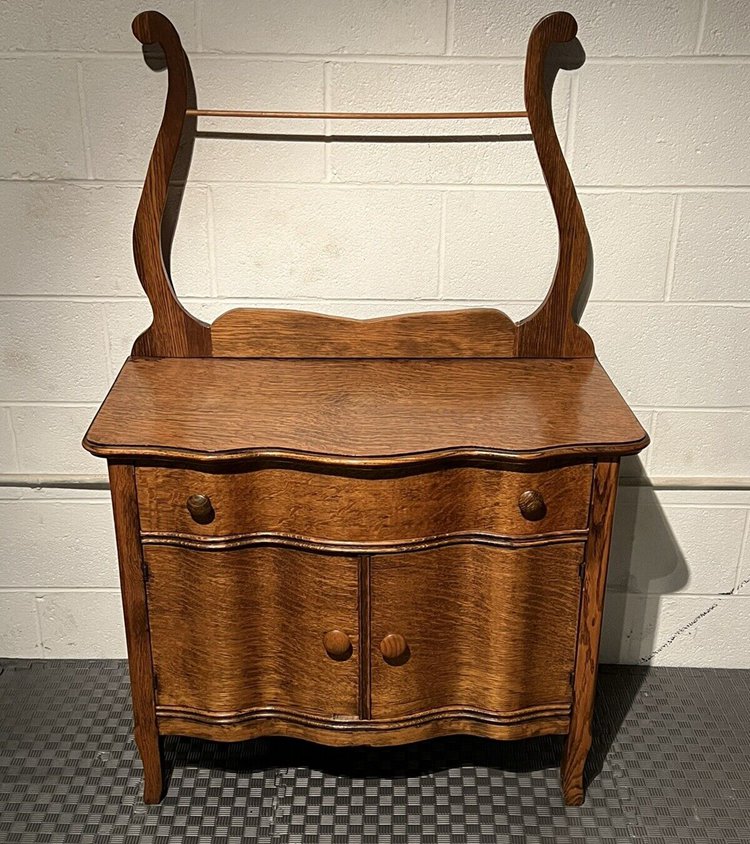
If you are someone who enjoys interior designing and is interested in adding an antique piece to your home space, then you are at the right place.
This article will intrigue you as we will give you all the information about antique wash stands to add a touch of antiquity to your homes.
Table of Contents
An Overview of Antique Wash Stands.
Wash basins were essential items in every household before the 20th century when indoor plumbing and sewage systems were not as widespread in the communal centers of a city.
These wash basins were instead a necessity to maintain daily ablutions and hygiene.
The wash basin was a versatile piece of furniture as it could be used for a quick bath, to wash dishes, and even as a washing machine.
Modern plumbing provides us with the option of hot and cold water. However, with a washstand, water has to be heated manually in a hearth or over a fireplace before placing it in the basin and the pitcher.
Because of the limited water supply available in these antique portable wash basins, people had to be very mindful about their water usage with the washstand.
The limited water availability also lowered the water waste. It also meant that every member of the family had to utilize the same water, which was a bit compromising in terms of hygiene.
By today’s standards, these antique wash basin cabinets don’t hold much practicality. Still, antique wash basins are popular among antique collectors mainly because of their aesthetic appearance.
These antique wash stands were beautifully crafted out of luxurious wood and ceramic inlaid with intricate and beautiful designs.
These antique wash stands are now not used with their original functionality. Primarily, antique enthusiasts or interior designers find some creative ways to utilize this vintage piece of furniture.
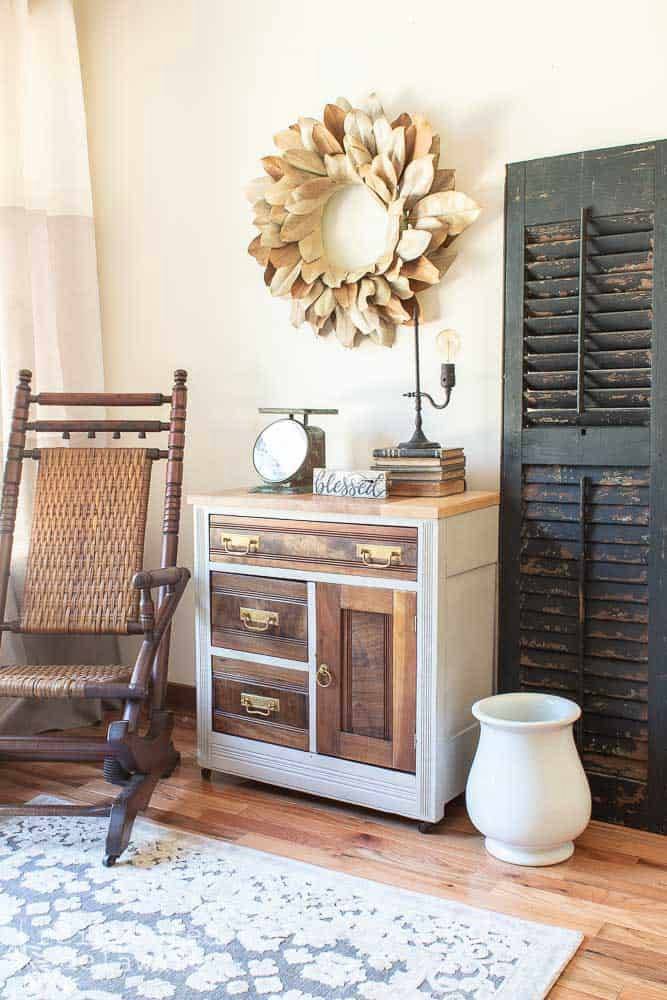
History and classification of Antique Wash Stands
The Wash Stand was introduced during the 18th century as public awareness regarding personal hygiene increased. The washstand would ideally be placed inside the bedroom, unlike a separate washing room.
The stand was often also used as a vanity in addition to working as a wash basin.
Most of the antique washstands from earlier times came without any storage cabinets. The stand consisted of a leggy structure, and it was built wide enough to accommodate a single basin.
A shelf would be placed under the basin cavity, which would function to hold the water pitcher.
Some stands would have enough space below the shelf to place a chamber pot in.
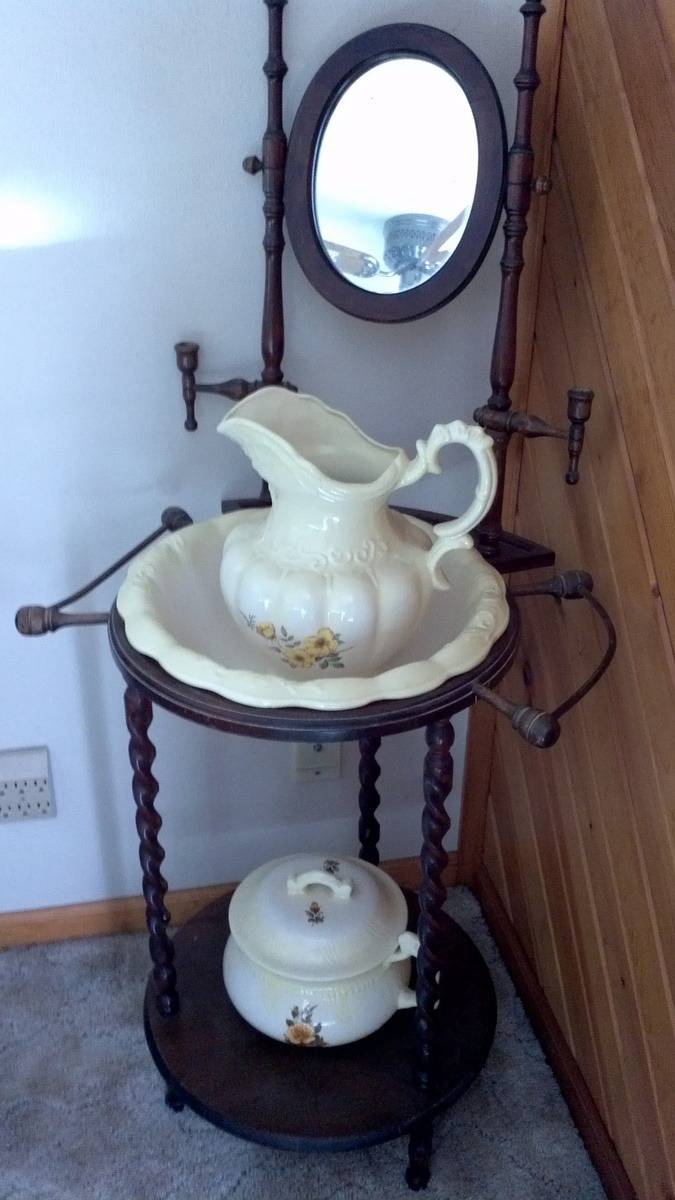
The wash basin eventually evolved over the years to include cabinets and small drawers. Thus they needed to be supported by four legs instead of three like the earlier models.
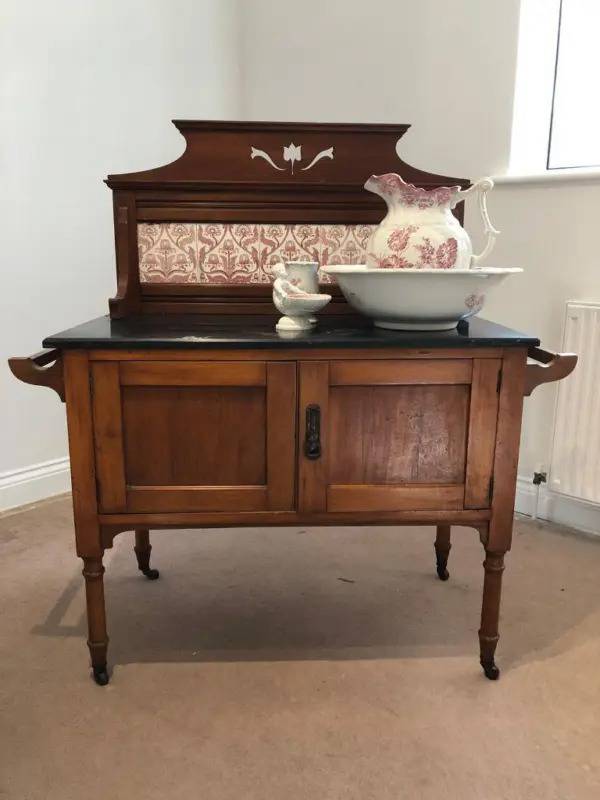
The washstands eventually grew in size during the Victorian era to be more accommodating. They would be fashioned out of sturdy oak, rosewood, or mahogany.
The stand had its back and top raised to hold more toiletries such as soap dishes besides the ceramic basin and pitcher. Mirrors would be added later to the stands, which would mimic the modern bathroom sink.
How To Tell Which Era Your Wash Stand Belongs To?
If you are unsure as to which era your antique wash stand belongs to, here is a little guide using which you can classify your antique wash stands and which era it could potentially belong from.
GEORGIAN ERA (1714 C. 1830 – 1837)
The earliest design of washstands is dated back to the Georgian era, where you’ll find the simple three-legged basin and pitcher sets.
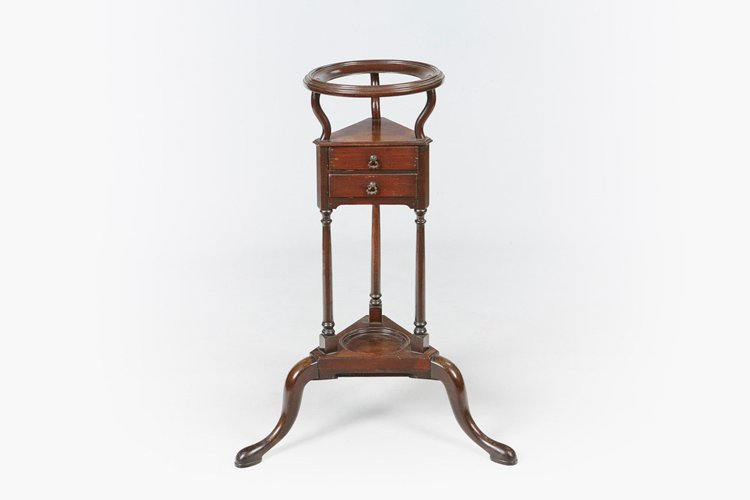
Some important features of these wash stands include:
- Leggy stands with almost no storage space
- It would usually contain two-tiered tables with a large compartment for the ceramic basin and pitcher.
- Comes in various sizes with identical features.
VICTORIAN ERA (1837 – 1901)
A finished marble top washstand was a common design throughout the Victorian era. If you happen to possess a washstand with a marble top, it is most likely to belong to the Victorian era.
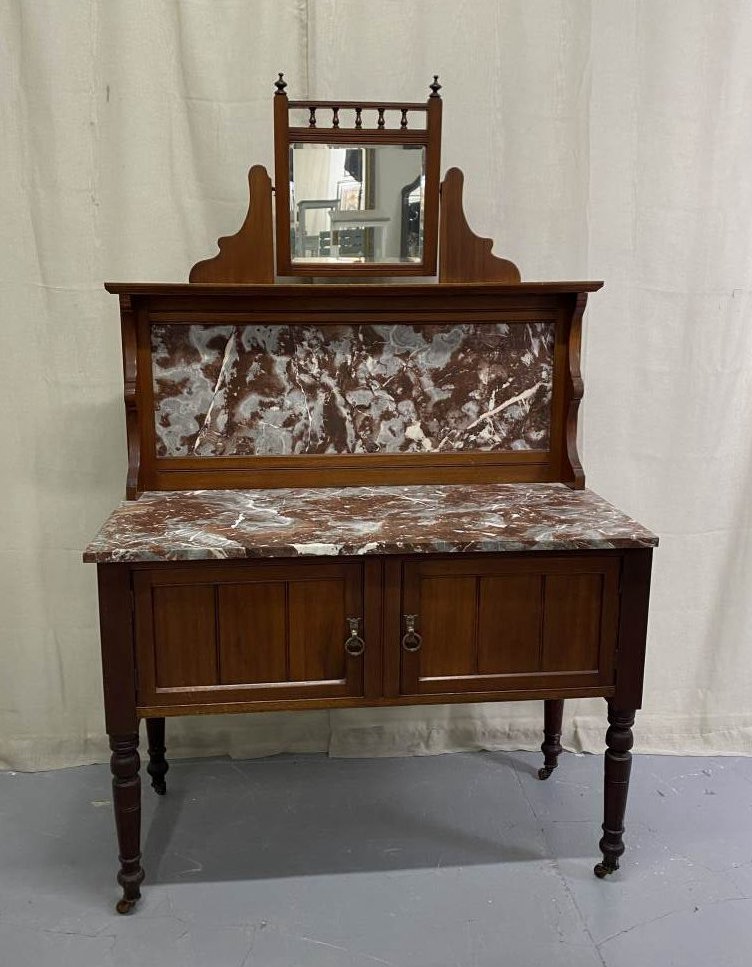
A Victorian-era wash stand commonly included
- Colored tiles and marble top shelf.
- The cavity for the wash basin was removed in order to increase the surface area.
- Drawer fronts were added to add storage space.
EDWARDIAN ERA (1901-1910)
The humble-looking washstand became a luxurious art piece during the Edwardian era with unique top shelves and decorative designs
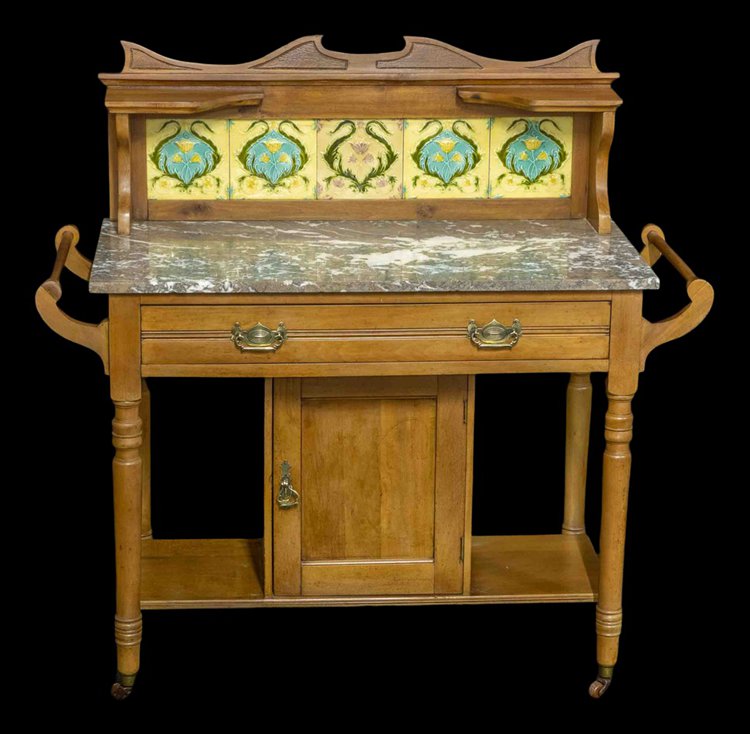
The primary characteristic of this type of Victorian washstand included:
- A flat surface area is often supported by a wide back and strong legs.
- Most Edwardian washstands would have mirror backs.
- Small drawers and compartments were added,
- Usually, a towel bar would be placed at the side of the stand.
- Innovative tops and wood carving were added for added aesthetics.
Identification and Recognition of Antique Wash Stands
Now that you have understood the different forms of antique wash stands, the next important question is how can you be sure whether your target antique wash stand is authentic or not?
Washstands are very familiar in style to dressers, drawers, nightstands, or the common traditional cabinets. However, there are some key features of an antique wash stand that can help in determining its authentication.
Hardware
Observe the nails and latches used in the hinges of the stand drawers and cabinets.
Why is this observation necessary? That is because the types of nails and bolts used in the stand can determine its age and period.
Brass hexagonal bolts were used in the Victorian-style washstand. Such types of bolts also showcase the wooden construction of the stands. Stands from the time period of the 1800s-1900 generally have these characteristics.
Drawers
Dovetails are usually found in antique wash stands to attach the front of their drawers to the side. These dovetails were often used as a joinery technique in antique woodwork.
If a washstand of your interest has five or more dovetails that are also matching, then you, unfortunately, have a fake antique stand in hand. An authentic antique wash basin has 3-4 dovetails on one side, which is hand carved and thus is always irregular.
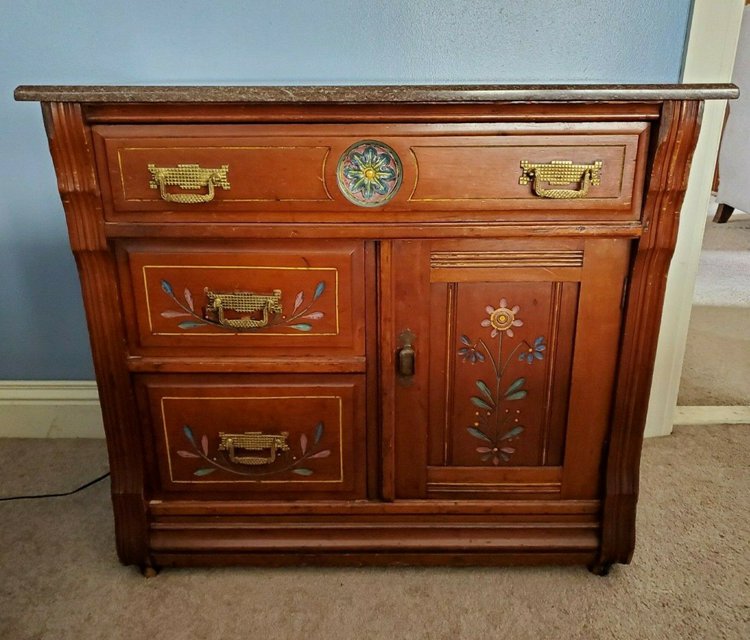
Pitcher/Basin
If you come across wash basins that come along with pitchers and sinks, then this means you have struck upon a stunning find. To determine whether an antique wash basin is authentic, it is essential that you look for its manufacturer’s mark.
Typically it’s hidden somewhere in an out-of-sight spot.
The sign of time is usually hidden on the underside of the basins or pitchers, which tells us when these objects were made.
Washbowl cutouts
Washstands come in all shapes, and their sizes, style, and function have radically changed with the passage of time as the designs went through a steady process of evolution.
Nonetheless, many features remain the same in functionality; for example, some washstands are fitted with shelves with an oval cut out in the center.
This cutout is made to fit the wash basin. Although it does not appear in most washing tables as the later Victorian and Edwardian style stand came with a flat marble top. The cutout makes it easy to swap out the basin and pitcher sets and personalize them according to one’s style.
Wood
Apart from the cutouts for the wash basins, the type of wood used in the manufacturing is the most distinguishable characteristic of an antique washstand.
Some of the older wash stands were constructed with oak mahogany and rosewood. These types of woods allude to the rarity of the stand.
Tops
The material used on a washstand top will help show its age and rarity. The use of marble surfaces had been a popular choice for washstands made in the early 20th century.
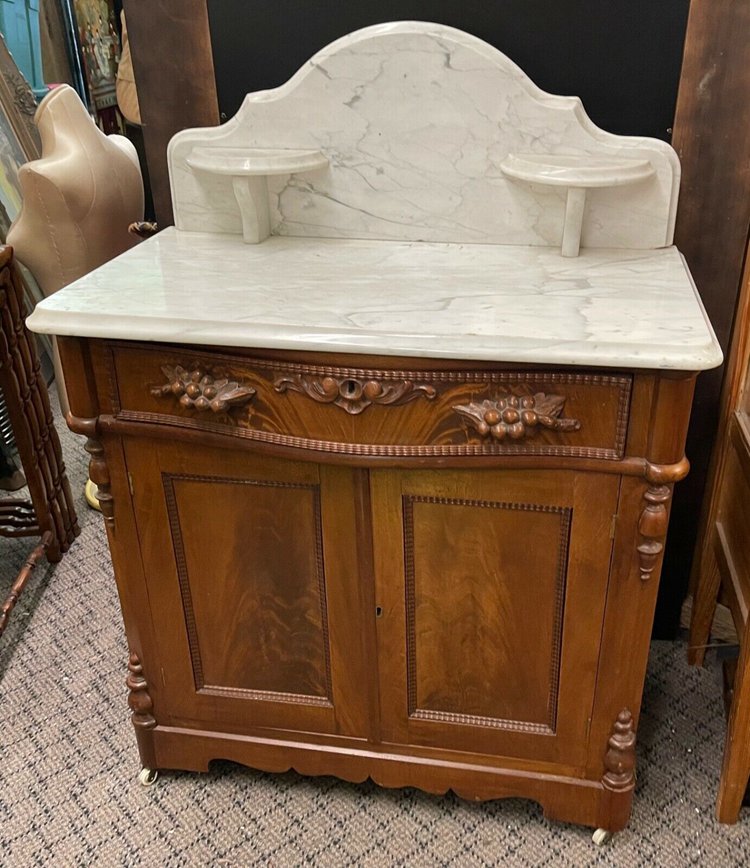
Size
As time passed by and domestic habits developed, the wash basin’s uses increased. Thus the wash basins were built wider in order to support other accessories like soap plates and gargle glass.
Older washstands from the Georgian era would have almost no vanity space except for the bowl cutout. Thus wide wash basins indicate that they’re fairly new. The older the washstand, the skinnier its wash basin is.
Towel bar
Newer wash stands would sport a towel bar to the side or above the basin on the stand itself.
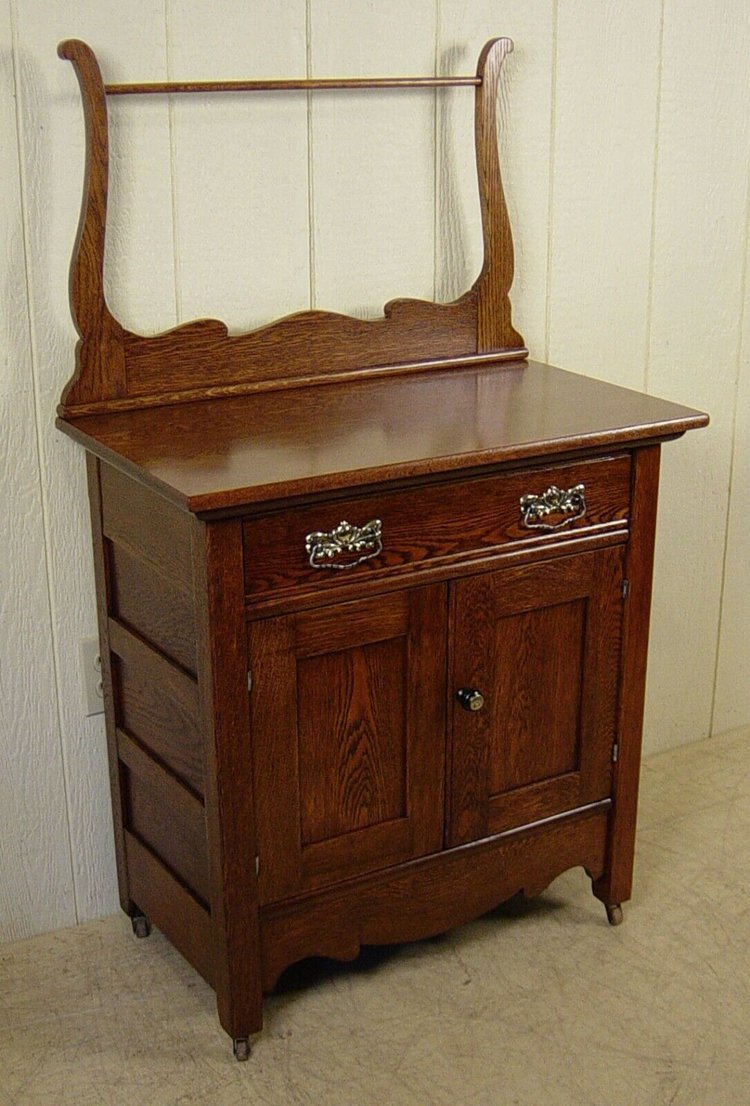
Brands
Many companies were at the forefront in the manufacturing of wash stands and pitchers, and their products can be found in antique shops and flea markets today.
Black English Ironstone
George Jones and Sons were among the companies that produced the Black English ironstone basin and a pitcher set.
The recently dissolved corporation was the rage of its time. The pieces can be found widely in flea markets, but unfortunately, they have not retained their novelty as their wash stands slowly went out of style.
Frankoma
Frankoma still continues its operation in the present. Their products included washing basins and pitchers in different sizes. Frank started the business in 1933 while working at Oklahoma University.
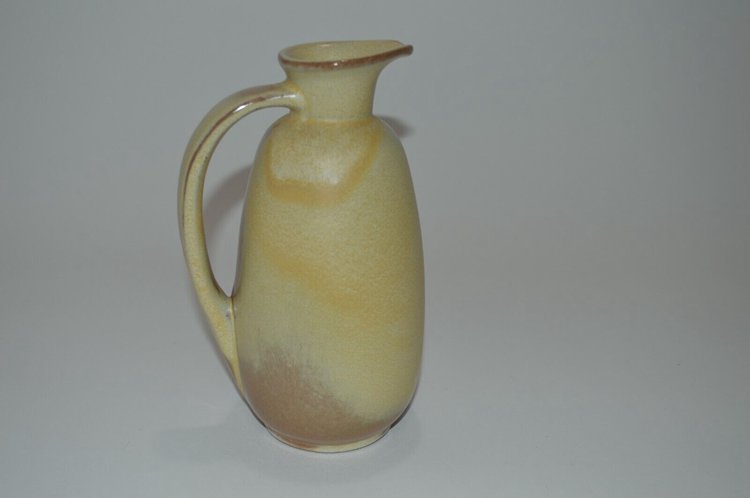
McCoy
McCoy pottery was initiated in 1848 and ran until profits fell and the company went into decline. The company’s official closing date was 2001. McCoy’s most popular pattern is Wildflower.
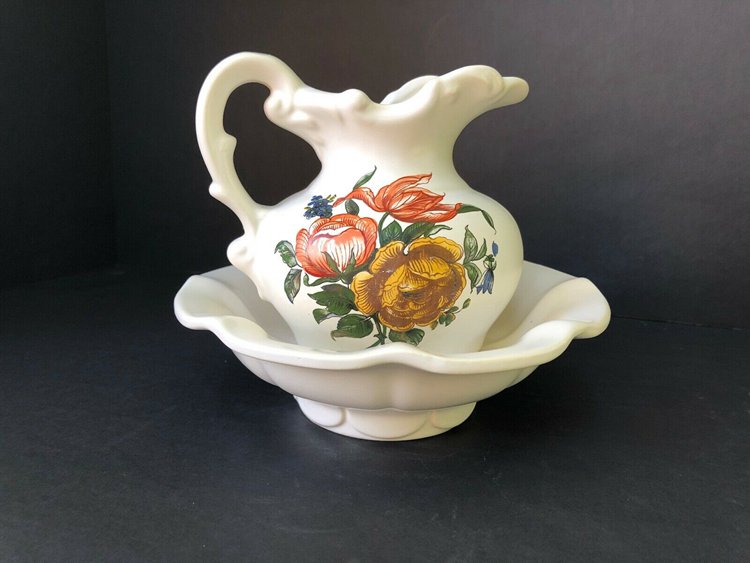
Crown Ducal
Crown Ducal pitcher designs are renowned for their large size and slim appearance. A. G> Richardson established the company in 1915 and sold it in 1974. The company eventually closed down due to bankruptcy.
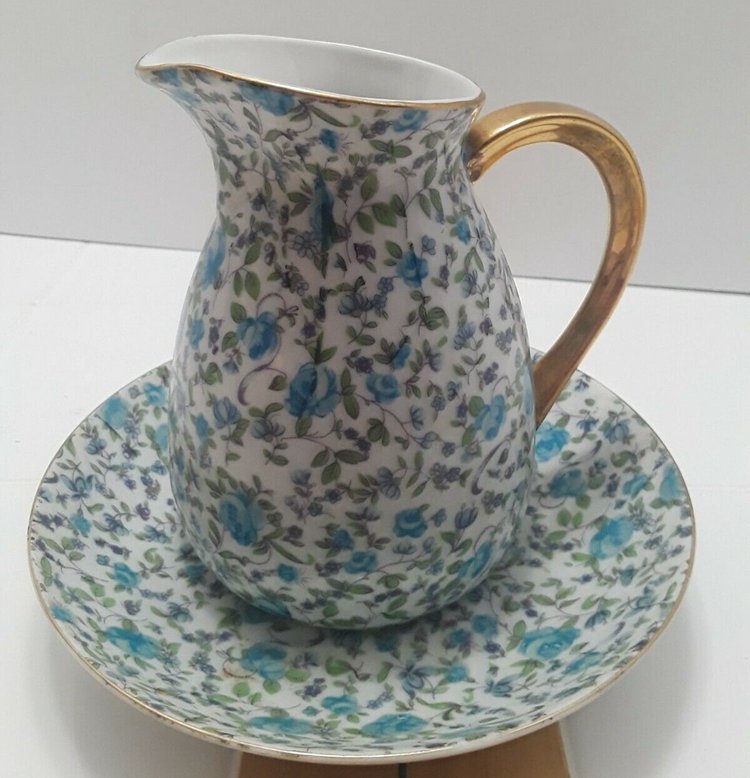
Roseville
Roseville pottery was known for its sponge-shaped pieces. They were popular during the early 20th century as their prices were low.
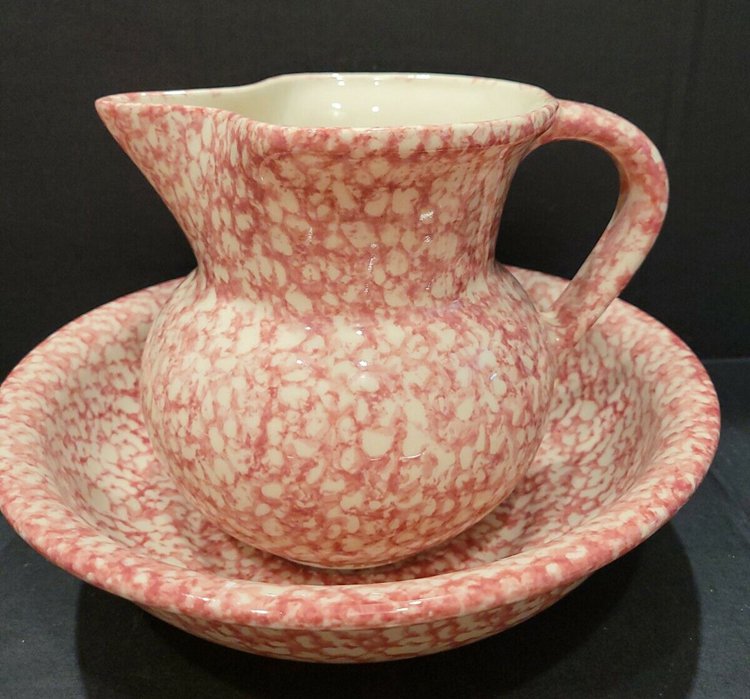
How To Repurpose Your Antique Wash Stand?
Washbasins are versatile pieces due to the abundance of drawers and cabinets. Their resurgence took place due to the revival of Victorian, American primitive, and country styling. They come in handy whenever you need that extra bit of storage space to tuck away your small necessities such as keys or letters.
They serve as beautiful pieces in your entry hall where they can be used to place your cellphone or groceries. The cabinets can be customized to function as a shoe rack where you can place your door shows.
Washstands with mirrors can be useful when you need that one last look before heading outside.
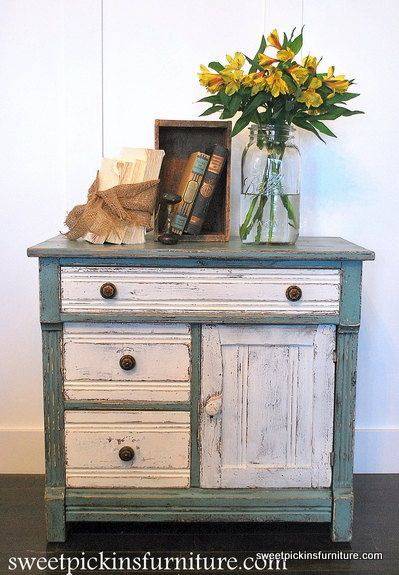
Due to the already existing built-in cabinetry in the washstand, they are often repurposed as vanity stations and dressers. Washstands with flat tops are popular designs as they look like regular cabinets once the basin is removed.
The beautiful wood can increase the ambiance of your room. If your washstand comes with a marble top, then it’s an excellent choice to be converted into a vanity.
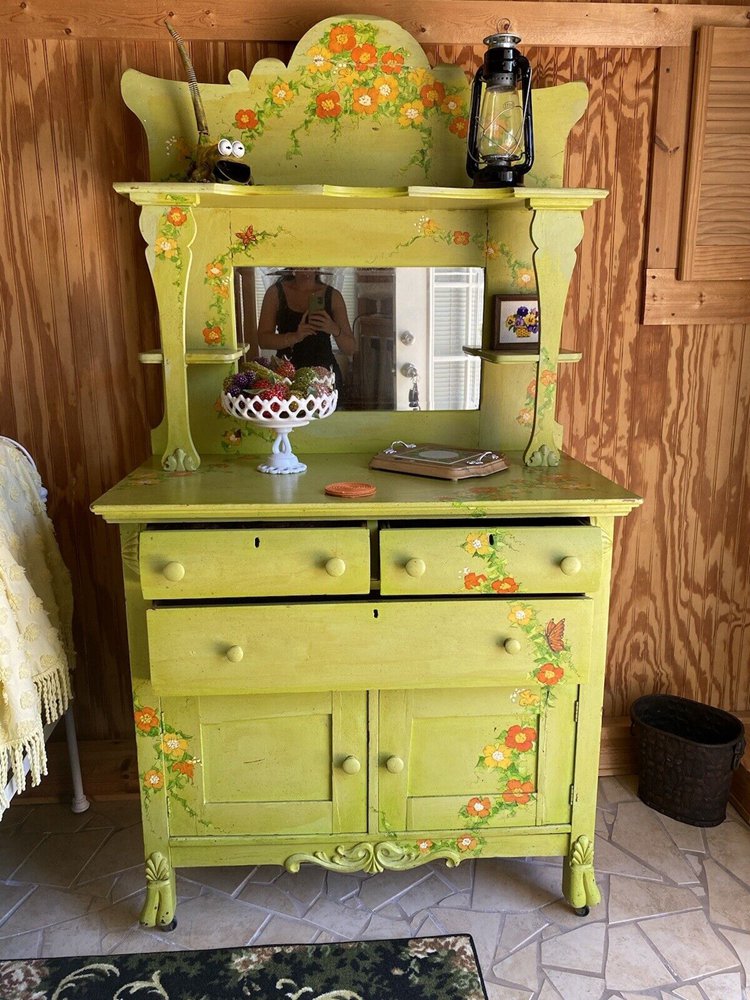
The wash stand can be repurposed as a unique coffee or kitchen station in your lounging area where you can easily reach out for a nice relaxing cup of coffee.
The cabinets and drawer fronts can easily act as storage space for your plates and coffee beans. Check out this customized wash table where the towel bar is repurposed as a mug handler!
Victorian pieces are usually fancy with intricate carvings or marble top shelf and can be utilized as parlor furniture.
Victorian Oak pieces, which are also called “golden oak washstands,” are streamlined pieces that can be easily found in auction houses and are a popular choice for repurposed parlor furniture.
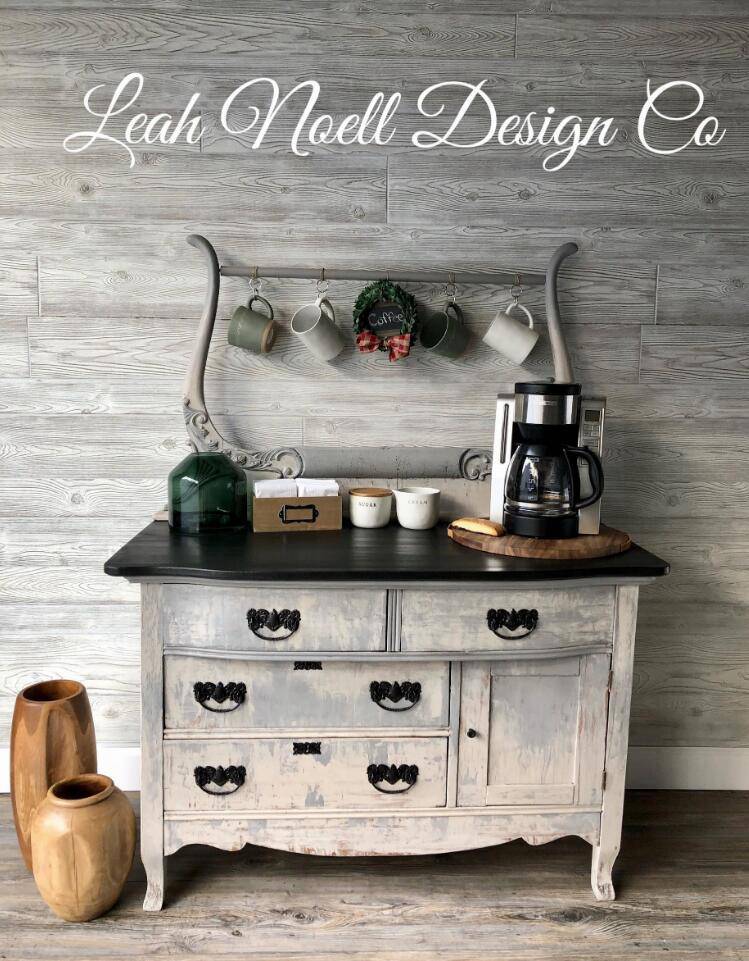
The wash basin’s original purpose was to be used in one’s everyday toilette routine. So why not use these antique stands for their original purpose again? Once they are fitted with modern plumbing, taps, and sinks, the stands make for an excellent bathroom sink.
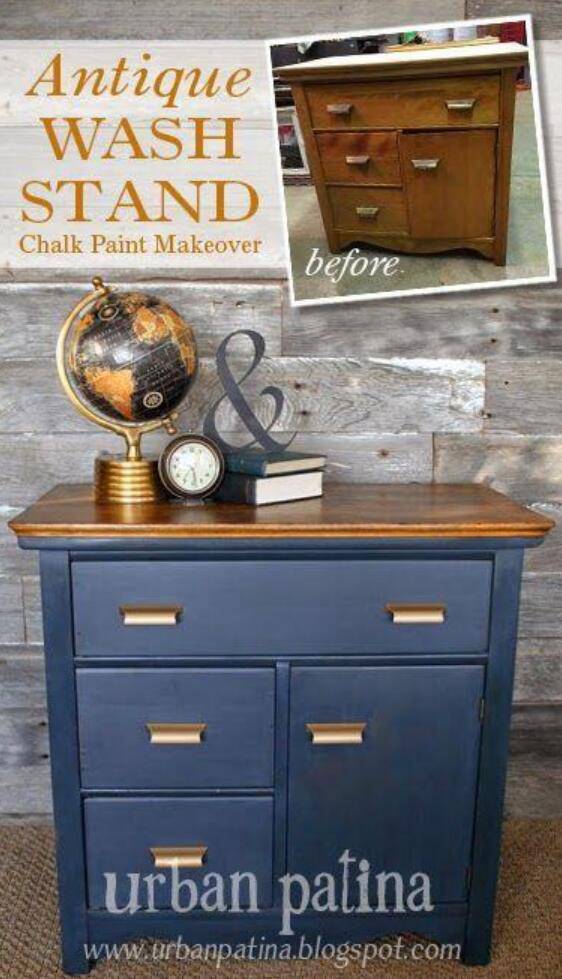
What Is The Value Of An Antique Wash Stand?
The value of antiques is usually based on the manufacturers and their quantity in the market. The more a piece is rare, the higher it is priced.
The age of the pieces and the presence of original accessories, and the condition of the antique itself determine its worth. Construction, material, and finishing are also important factors in highlighting the piece’s value.
These antique pieces are a part of history, and they are usually priced starting at a couple of hundred dollars, to say the least. Antique wash stands were items of luxury even for their time as they were usually owned by the well-off bourgeoisie or the elite.
Thus, they are made with expensive materials such as mahogany and marble, so they are usually priced around $500-$700. Rare and exquisite washstands with unique designs can be priced at even thousands of dollars.
An antique wash stand with mirror value of more than $500 are quite pricey if the mirror is without any damage.
So, it depends on the collector what sort of pieces they are looking for.
If you are in possession of an antique desk or a washstand and want to know about its precise value, then you should seek the service of a professional furniture appraiser.
It should be noted that there are various kinds of appraisals based on the reason you want your antique appraised. You might want to appraise your antique piece for market value, tax value, or insurance. Depending on your reason, the price may differ. Thus, be sure of your purpose.
There are multiple ways in which you can approach a certified professional appraiser.
You can contact your local antique shops or antique dealers and add a request for the services of accredited professionals.
There is an abundance of online sites that deal with antique furniture, and usually, they will have the contact information of various appraisers. The Appraisal Association of America has an extensive list of appraisers relevant to different fields, and it gives you an open option in choosing an appraiser.
This website is highly convenient as it provides the appraiser with a written exam before issuing them with a certificate.
An appraiser is required to have at least five years of experience before they can be considered as a senior on the site. So you can rest assured about getting your money’s worth.
If you are in possession of an extremely rare or valuable piece, then your best option will be to approach auction houses in order to keep the value of your piece.
Where Can I Buy An Antique Wash Stand?
There are various sources from where you can buy antique washstands. Flea markets are always equipped with vintage and antique items. It requires a little bit of luck in flea markets to source something valuable truly.
Yard sales are another popular source for antique buyers where you can come across some wonderful family possession rich in history. Antique stores are a straightforward and reliable option for antique sellers as they source their items from various fronts.
Online sites are also a convenient option for antique collectors. However, it can be quite pricey when it comes to online shopping as it adds the separate cost of shipping, packaging, and taxes. Plus, there is also the added uncertainty and anonymity regarding the seller and the product’s condition.
Thus, we always recommend checking out authentic sites.
Here are some of our suggestions:
eBay
eBay is one of the reigning sources on the internet when it comes to online shopping for antiques. You will find a wide variety of Antique wash basins from different eras and manufacturers.
The price can range from below a hundred dollars to more than $500. This site also gives you the option of buying basins and pitchers separately.
Etsy
Etsy is an expansive e-market site with a major focus on arts and crafts supplies and home businesses. It provides a large section, especially for antique items and other collectibles.
As the site acts as a hub for handmade items, you will find various customized wash stands or unique hand-carved accessories for your furniture for optimal personalization.
Vatican
The Vatican is a dedicated site for giving tourists a look around Rome. It’s no surprise it has a section where you can find authentic vintage pieces from eras bygone.
Craigslist
Craigslist boasts a wide variety of antique items are one of the largest advertisement websites on the internet. The site allows you to tailor an ad for a particular style of antique that you want. It also allows you to sell your own antique piece to a targeted audience.
You can conveniently search for the antique wash stand of your dreams.
Antique World/ Love Antiques
Antiques World and Love Antiques are also online antique stores that often have washstands for sale. You can also get beautiful accessories for reasonable prices or replacement materials for any missing parts in your washstand.
Here are a few tips from us:
- Whenever you venture out for antique wash stand shopping, always pry keen eyes towards the quality and condition of the wood.
- If the wood appears spongy or bloated, it might have been exposed to a humid environment or kept in a place full of moisture. It is unlikely that you may cross a washstand in mint condition, so it’s ok if there are mild scratches on the wood.
- Look out for lightweight and rickety pieces in your washstand because they might hinder your plans on repurposing the wash basin with modern plumbing. Weak pieces will not support a granite or stone stop if you plan on installing one.
- Always carry a measuring tape with you when you go antique shopping. You don’t want to make the mistake of picking out the wrong size bowl set for your washstand.
- Last but not least! Don’t forget to generate a receipt from the buyer dealing with every detail regarding the item.
Buy Antique Wash Stands Amp Your Home Space
Antiques are charming because of their slight wear and tear. Their attractiveness can be maintained if they are well cared for.
Antique wash stands are beautiful pieces with so many uses now that their original purpose has disappeared. It is the collector who gives new life to these pieces of history.
By now, you must have developed a thorough understanding of various styles of wash stands, how to identify the authenticity of an antique washstand and where to buy them.
If you have any more queries or confusion, you can contact us through our email. We will be anxiously looking forward to your participation.

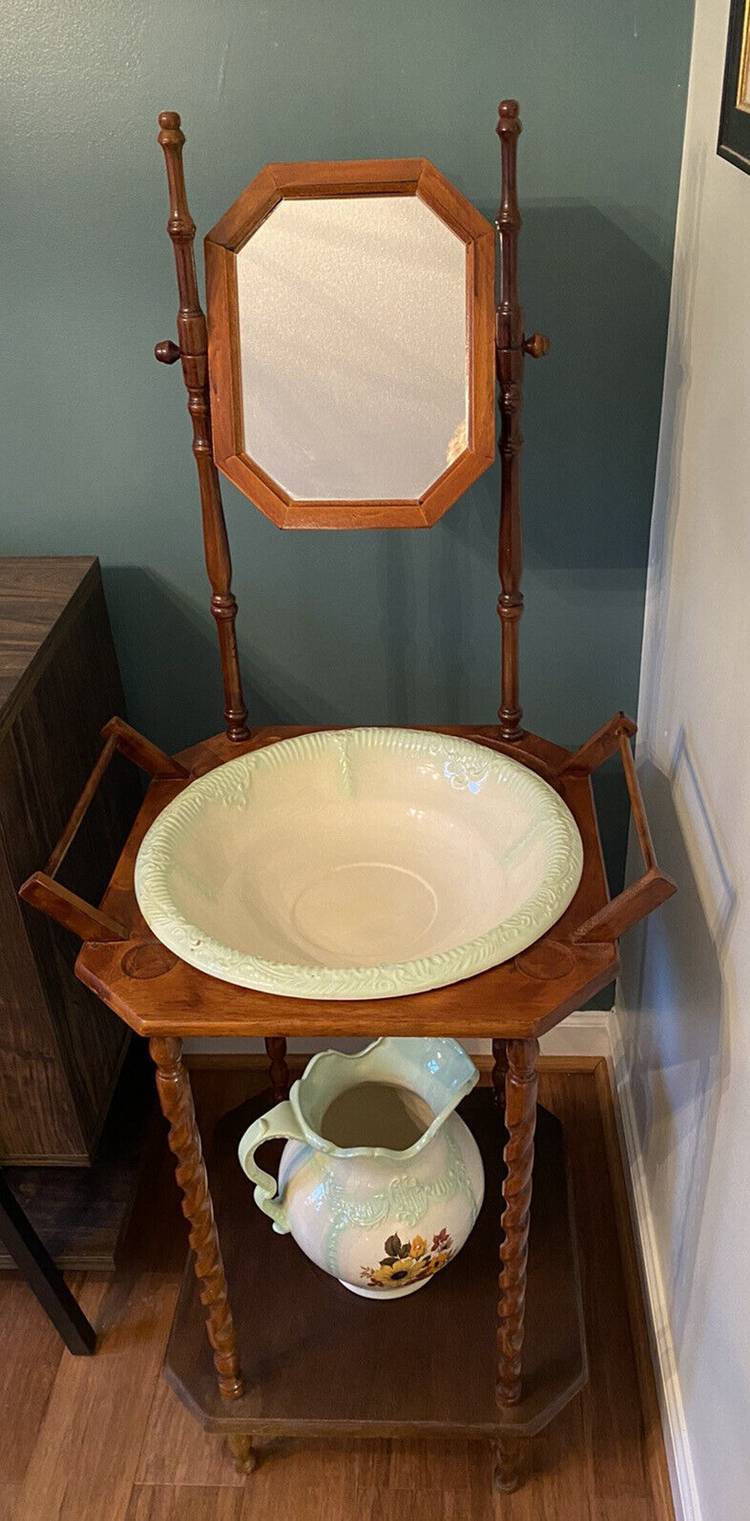
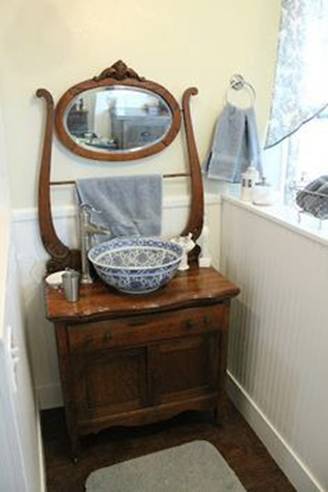




![Where To Sell Antique Furniture In 2022 [Ultimate Guide]](https://www.jacquelinestallone.com/wp-content/uploads/2022/09/Etsy-Your-Place-To-Buy-And-Sell-All-Things-Handmade-600x450.jpg)


